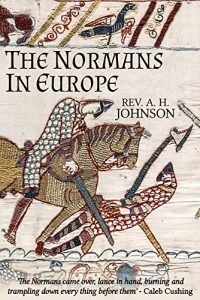In the Eighth Century, the Northmen inhabited Denmark, Sweden and Norway.
These Northmen were believed to have branched off from the Teutonic family of the Indo-Europeans.
Little is known about the early Northmen settlers, but later knowledge suggested they were agricultural people.
The conquests and settlements neatly fall over two periods. The first period was merely incursions of perceived necessity.
Johnson focuses much of this book on the events that took place during the second period: a period that was riddled with conquests and definite settlements.
Johnson’s account paints a detailed depiction of what the Northmen, or Norsemen, may have looked like and the vessels they used in times of war.
A clear picture of warriors, whose only objective was victory during their missions.
However, much of the Northmen’s way and belongings hadn’t been invented by themselves. They were more inclined to adopt the ways of their adopted country.
The Northmen, a collective appellation used for Norwegians, Swedes and Danes, was considered apt due to the varying nationalities of the men. The nature of their conquests focussed solely on the conquering of different nations. Their objective was to consolidate regions in the countries.
The conquering of England naturally led to three divisions: The Orkneys and Shetlands, The western Isles as far as Ireland, and Iceland and the Faroë Isles. Some of the Northmen sought peaceful settlements, which the Orkneys and Shetlands provided.
With every conquer, settlements and states were formed. These were established in England, Scotland, Iceland, Wales, Finland, Greenland and even extended to Italy. Some of the Vikings, the Northmen at the forefront of the battles, were savage in nature. Their incursions across Europe were met with resistance.
Parts of the lands rose up against the Northmen, which naturally led to a further divide within the nations.
Rev. A. H. Johnson portrays the Scandinavian Exodus in great detail. Covering the conquests over the two periods, Johnson aims to connect the incursions and emphasise the sequence of events that led to the Norman Conquest.
Rev. Arthur Henry Johnson (1845-1927) was an Oxford academic. He was also the author of A History of the Worshipful Company of Drapers.






